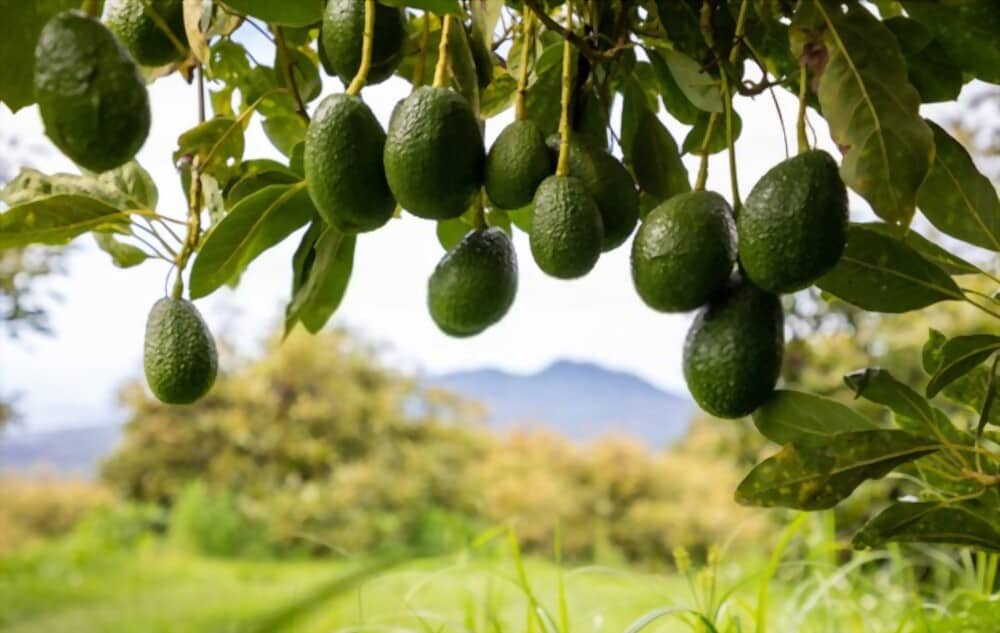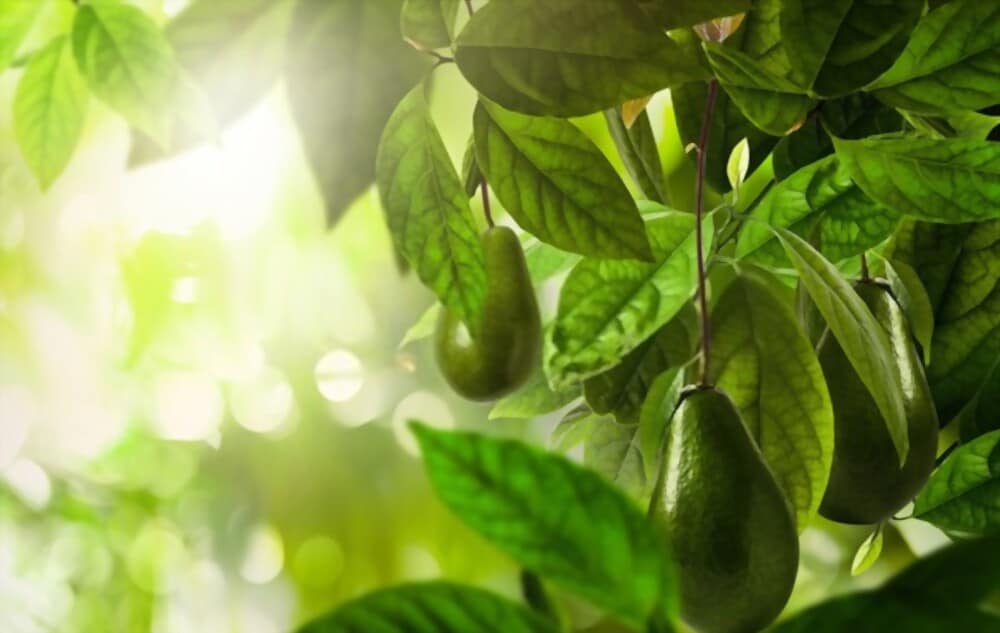
The avocado is a berry that resembles a bulb or a pear and has a single seed enclosed in a thick layer of flesh. The avocado fruit’s coveted coating, known for its heart-healthy fat content and particular flavor, is the most valuable section of the fruit.
The Pollock variety, a vigorous spreading West Indian variety with rectangular to pear-shaped fruits that can weigh up to 2.27 kg, produces the avocado fruit with the biggest size (5 lbs). The fruit can grow up to 7 inches long and have a diameter of 2.5 to 6 inches.
Tall, evergreen avocado trees have broad, forest-green leaves and open, low-branched canopies. With luscious green, elongated leaves, branches can begin from the base between 4 and 6 feet from the ground. Avocado trees have the unusual ability to lose their leaves and develop a new set once every two years.
The avocado (Persea Americana Mill) is a member of the Lauraceae family. It is a species of flowering plant found in tropical and warm areas all over the world. The dwarf variants of the trees can reach heights of 4 to 15 meters (13 to 80 feet), or between 4 and 8 feet.
The skin of avocado fruit can be smooth or rough, and some varieties ripen to a brown color while others, like the West Indian pollock, develop to a pale yellow color.
Table of Contents
How to Know When the Fruit is Ripe or Ready to be Eaten?
Contrary to popular belief, fruit doesn’t ripen on the tree. Instead, they are harvested or selected when they are fully grown and given two to three days before they are ready to be consumed.
The fruit (West Indian pollock) is hard and green when it is picked, but after a few days it begins to ripen, and the skin gradually turns a pale yellow tint. The avocado fruit should be cut when the texture of the outer layer begins to gradually soften.
When determining whether a fruit is ripe, you must use mild pressure because excessive pressure will harm the fruit and cause the interior to turn dark green.
How long does it take for an avocado tree to bear fruit?
While dwarf or grafted plants may take between three and five years before they begin producing fruit, an avocado tree grown from seed may take five to ten years to mature and start doing so.
Although according to studies, it takes 3 to 5 years for a grafted avocado to bear, in my own experience I have found that some types, like the pollock, can bear in as little as two years and can do so in a very constrained space before being harvested and sold.
According to my experience, avocado trees initially only produce a small number of fruits, but as the years go by, they start to produce an increasing number.
The age of fruit-bearing may vary amongst plant varieties depending on the variety and climatic conditions.
How can an Avocado tree produce more fruit?
Avocado trees are self-pollinating or self-fertile, so they don’t always require another tree to produce fruit. However, avocado trees are available in both male and female kinds, and having both types of plants helps boost pollination and, as a result, fruit production.
Based on their flowering patterns, male and female avocado varieties are divided into the A and B variety categories.
Group A: Flowers bloom in the morning (about 6:00 a.m.) as female, close around noon, then reappear in the afternoon the following day as males.
Group B: Flowers open at noon as females, close at 4:00 p.m., and then reopen the following morning as males.
Group B pollinates Group A in the morning, while Group A pollinates Group B in the afternoon.
This is the method avocado producers use to boost crop yields for optimum profit. Having these two kinds of plants nearby considerably increases crop productivity.
Can Avocado trees grow Indoors when potted?
You can cultivate avocado trees indoors. Despite the fact that dwarf forms of the avocado plant may not yield as much fruit as a normal tree, dwarfing avocado trees has allowed farmers and home growers to put the trees indoors, especially in temperate countries where the cold frequently drops below 35F. The avocado tree may die under these temperatures.
When grown in a pot, a dwarf avocado tree can typically reach heights of 2 to 3 meters, or 4 to 8 feet, while continuing to provide fruits of normal size. When planted in the ground, the tree may occasionally grow bigger than this.
Since avocado trees grown in pots are enclosed environments, they require more frequent watering and fertilizer applications than plants grown on the ground.
Similar to outdoor, earthed avocado plants, potted avocado cultivars need a 10:10:10 ratio of NPK fertilizer with the required trace elements. This fertilizer should be sprayed twice a year, not at the base of the tree but rather around the canopy.
Replanting a seed from a dwarfed tree might not give the same dwarf result as the parent avocado tree because potted avocado trees are specifically designed to flourish in compact spaces. You must graft or air layer a sprout onto another tree in order to grow another dwarf avocado tree.
The final pot size should be sufficient to hold the plant when it reaches adulthood, even though the tree can be grown from a seed and initially be placed in a small growth container that is between 6 and 10 inches in diameter.
To allow enough room for roots to grow, a container with a diameter of 24 to 36 inches is suggested. To ensure proper water drainage out of the plant pot, the pots should be fitted with holes at the bottom.

Growing an Avocado Tree from the Seed
Growing avocado plants is straightforward. One seed soaked in water and planted in a shallow area can produce an entire tree. Like other plant seeds, the avocado seed has the nutrients needed for early growth contained inside of it. Two weeks later, roots may be seen extending into the water.
Instructions –
- Take the Avocado’s seed out.
Cutting an avocado with a knife will accomplish this. While doing this, be delicate and take care not to cut into the seed.
How to Grow Avocado Seeds
- The proper placement of the seed is crucial because it will result in the growth of roots at one end and a plant shoot at the other. Usually, the plant shoot’s sharp end should face upward.
- Supporting the Avocado Seed with Toothpicks – Depending on how heavy the seed is, you may need to use 3 or 4 toothpicks here. Now pierce the avocado seed with the toothpick at a slight downward angle so that it sits partially submerged in the water when it is placed on the holding jar.
- Place the Avocado Seed in Water – The avocado seed should be slightly submerged in water in a transparent jar or container. The seed needs to be planted close to a location with moderate sunlight. This will guarantee the seedling receives the energy it requires when it eventually shoots out. If there are any indications of fungal development, the water quality should be checked and altered.
- Have you ever planted a red bean in a wet napkin? The wait is typically 3 to 6 weeks for sprouting. This process is comparable to that, and as the seed ages, it will eventually go through similar changes and dry out. If it is not neglected, the roots will begin to show, followed by the shoot, and then everything will go uphill.
- When the seedling is about 2 to 3 inches tall, it can be potted in nutrient-rich soil. The seedling can be planted in a container with drain holes that is 6 to 10 inches in diameter. You might use a potting soil blend. Fill the pot with potting soil until it’s about halfway full, without packing it down. When the dirt reaches the root of the seedling, add the seedling and top it off. In order to give the plant enough aeration, the soil is not compacted.
- Watch the plant grow by placing it in a moderate amount of sunshine.
On the other hand, if you have avocado trees as I do, you will observe that little trees are sprouting at the parent tree’s base. This is due to the fact that not all of the fruit matures on the tree. Some avocado fruit that falls to the ground rots and grows into new avocado plants.
If you already have trees in your yard, this is a simple way to get new plants.

FAQ
How do I know if my avocado tree will bear fruit?
It will take your avocado pit-grown tree at least 10 years and maybe up to 15 years to begin bearing fruit. But if you planted a tree from a nursery or garden center, it should start to bear fruit in three to four years.
Do avocados like sun or shade?
Sun and cover Hass avocado trees flourish in direct, strong sunlight that isn’t filtered. They can tolerate light shade but require at least six hours of direct sunlight each day. The leaves will reflect more light, the better.
Will a single avocado tree produce fruit?
Once it is roughly 5-7 years old, an avocado tree may produce 200 to 300 fruit per tree. On the other hand, the avocado tree bears in cycles. This implies that the tree can yield a huge crop one year and a tiny crop the next.
Where is the best place to plant avocados?
Pick a location that receives full sun, has great drainage, and is shielded from wind and frost. Give the tree plenty of space to grow to its full size. Avocado plants can grow to be 40 feet tall or more in the ground, however containers limit plant size.
How long does it take for the avocado tree to bear fruit?
The key to success is perseverance, whether you start with a tree that has been cultivated in a nursery or from seed. You must wait three to four years for fruit after planting a tree. Start with a seed and wait for at least 13 years. The wait is still worthwhile because homegrown avocados have a unique quality.
